#blame raven for this
Explore tagged Tumblr posts
Text
Wymack was ready to propose to Kayleigh, but choose to leave to not overstep Kayleigh boundaries. Wymack called Kayleigh to know if Kevin was his and was ready to be a dad, but she said no so Wymack let it go. He sees Kayleigh everytime he looks at Kevin.
Betsy developed an unnoticed way to call Andrew's attention when he is going anxious and trying to hurt himself. That way he stops and nobody notices.
Andrew accepted joining PSU because it was Aaron's opportunity to study medicine and became the doctor their mother couldn't believe he could be.
Aaron was able to see through Andrew's denial about his feelings for Neil. Because he knew his brother ticks, expressions and mannerisms better than he let it show.

#nora I am blaming you for my emotional instability since i read these#the way this characters continue to amaze me#palmetto foxes they could never made me hate you#psu#aftg extra content#all for the game#the foxhole court#the raven king#the kings men#nora sakavic#david wymack#betsy dobson#kevin day#kayleigh day#aaron minyard#andrew minyard#neil josten
2K notes
·
View notes
Text






























The Pantheon of Exandria;
"One thing, Dad. [Mortals] don't fear you, they resent you."
No Children by The Mountain Goats // Critical Role: Campaigns 1 and 3, Critical Role's Downfall
#this has been rotting in my head for months. freeing myself of it by tossing it into the sunday night void.#i blame laura bailey's choice to have the matron poke at the gods paternalism and bells hells as a party#for having the general disposition to the gods that is akin to that of children discovering for the first time that their parents are human#cr downfall#critical role#exandrian pantheon#long post#my post#web weaving#brennan lee mulligan#ashley johnson#matthew mercer#laura bailey#abubakar salim#nick marini#noshir dalal#taliesin jaffe#sam riegel#aabria iyengar#the wild mother#the arch heart#the everlight#the lawbearer#the matron of ravens#the dawnfather#the emissary#cr3#exu downfall
710 notes
·
View notes
Text
the foxes doing the hear me out cake challenge and who/what I think they’d put on there
Neil: Andrew Minyard, Kevin Day
Dan: Mufasa (Lion King), Filmore!, the weather app, the red M&M, Weaver (Antz), Scully (Monsters Inc.), Diego (Ice Age), Manny (Ice Age), the purple M&M, Mr. Clean, Bob Duncan (Good Luck, Charlie), Jimmy Neutron’s mom, Kevin Day
Andrew: Wymack (pissing Kevin and Dan off but the rest of the team agrees with him), Neil Josten, Ghostface, Chucky, Rumpelstiltskin (Shrek), the sound of glass breaking, a baseball bat, Wymack a second time, Gerard Way, Ben&Jerry’s peanut butter & cookies specifically, Kevin Day
Aaron: Jessica Rabbit, Lola (Sharktale), Candace (Phineas and Ferb), Fiona (Shrek), the dragon (Shrek), Sally (Cars), Matt’s mom, the green M&M, an aglet, an old fashioned quill and ink, swiss cheese, Peach (Super Mario), Kevin Day
Matt: Sarabi (Lion King), Sandy Cheeks (SpongeBob), Andrew’s car, King Julien (Madagascar), Neil Josten, the “Jules” desk chair from ikea, the fairy godmother (Shrek), peach (the fruit, cmbyn style), Birdo (Super Mario), one of those sheet face masks, marshmallow fluff, Kevin Day
Allison: Balto, Scar (Lion King), a snickers bar, a salt lamp, Jack Skellington, Emily (Corpse Bride) (yelling ensues because both Emily and Jack are just hot), Diego (Ice Age), Dr Drakken (Kim Possible), the dad from inside out, the invisible man (Hotel Transylvania), Kevin Day
Nicky: Gill (finding Nemo), Diego (Ice Age), Major Monogram (Phineas and Ferb), Christmas ornaments, groan tubes, the Belgian techno anthem “Pump Up The Jam”, Sauerkraut, Bloaters/Shamblers (The Last of Us), Coriolanus Snow (The Hunger Games), Barry B. Benson (Bee Movie), the German word “Potzblitz”, Kevin Day
Renee: a literal rainbow, the Mona Lisa, a swiss pocket knife, a braided brioche loaf, Ghostface, Haymitch Abernathy (The Hunger Games), Barbie (the actual doll), the beast (Beauty and the Beast), Mrs. Potts (Beauty and the Beast), Andrew Minyard (earning a silent high five from him and Neil), Kevin Day
Kevin: some very niche historical figures, the onceler (the Lorax), a literal exy racquet, Gloria (Madagascar), a three sixty vodka bottle, Shego (everyone yells at him that she’s not a hear me out; she’s just hot), Allison Reynolds (earning a side eye from her), Matt’s mom
Bonus:
Katelyn: Dr Doofenschmirtz (Phineas and Ferb), Vanessa Doofenschmirtz (Phineas and Ferb), Sally (Cars), Andrew Minyard (Aaron is disgusted), Ron Stoppable (Kim Possible), Timon (Lion King), Balloony (Phineas and Ferb), the number 8, the periodic table, the electronic configuration of phosphorus, Jordi (The Secret World of Santa Claus), Gordon Ramsay, Kevin Day (Aaron high fives her)
#everybody wants to fuck Kevin#and I can’t blame them#idc that this is ooc#should I do a part 2#all for the game#aftg#aftg shitpost#aftg socmed au#socmed au#aftg social media au#aftg socmed#Kevin day#neil josten#andrew minyard#aaron minyard#allison reynolds#nicky hemmick#dan wilds#matt boyd#renee walker#katelyn mackenzie#andreil#david wymack#kandriel#kevaaron#kevallison#the sunshine court#tsc#the golden raven#tgr
625 notes
·
View notes
Text
my toxic aftg trait is my ability to ship kevin with absolutely anybody. kevneil? doomed childhood acquaintances to strangers to lovers pipeline is real. kandrew? they literally kept each other alive. it doesn’t get more romantic than that. kevjean? probably the most tragic relationship in the books, they make me insane. kevjere? give that man a golden retriever boyfriend! kevaaron? MY crackship. fuck it, i even see the kevnicky and kevallison vision. case in point, i will literally be happy with him dating anyone besides his canonical girlfriend
#‘thea wasn’t that bad’ she victim blamed jean i hate her#all for the game#aftg#the foxhole court#tfc#the raven king#trk#the kings men#tkm#kevin day#neil josten#kevneil#andrew minyard#kandrew#jean moreau#kevjean#jeremy knox#kevjere#jerekev#aaron minyard#kevaaron#nicky hemmick#kevnicky#allison reynolds#kevallison
414 notes
·
View notes
Text
When Melissa tried to flirt with Neil:

#or really just in general#man had a one track mind#his brain was all about Andrew and honestly?#cant blame him#aftg#all for the game#andrew minyard#neil josten#andreil#the kings men#tkm#the raven king#trk#the foxhole court#tfc#aftg shitpost#all for the game incorrect quotes#all for the gay#all for the game my beloved#aftg meme#trk meme#tfc meme
2K notes
·
View notes
Text
I had sort of hoped Keyleth would have matured and grown past her anger at the Matron over the past 33 years but I suppose it's in character that she hasn't fully dealt with her grief yet. And the Vorb probably isn't helping her issues either. It just sucks because I think a lot of the fandom take Vox Machina's grief fueled blame and fully accept it as fact when the reality is that Vax's situation is almost entirely his own responsibility. The only other person with any remote culpability is Percy. And even Percy is only really to blame for accidentally Killing Vex, not for Vax's choices. But even if you want to hold Percy accountable for Vax's choice in the tomb as well, that still doesn't make him responsible for Vax's death. Vax could have lived a long full life as the Matron's Champion, as shown by the Delightful Purvan Suul and his companion Galdric.
Vax was a borderline suicidal, self-sacrificing character from day one. He always threw himself into danger headfirst regardless of the cost to himself. Between Percy accidentally setting off the trap creating the circumstances for Vax trading himself to the matron during Vex's resurrection, all the way up to Vax CHOSING to come back as a revenant after being disintegrated in order to help defeat Vecna, the choices have always been his. Especially him, fate touched as he is. Ultimately, Vecna killed Vax and Vax killed Vax. I think it's easier to blame the Matron than to be angry with Vax for being who he was.
The Matron maintains the balance of life and death. She accepted Vax's offers both times, do you think she should have refused? The first refusal would have meant Vex's death, and the second refusal would have meant Vax possibly just staying dead after being disintegrated, and not being there to fight against Vecna, which was truly an all hands on deck situation. There was no time to fuck around with a resurrection ritual that might not even work, the whole world was in danger. One life, a life that was already lost, is a small price to pay to save the world. I'm pretty sure Vax would agree with me!
Frankly, Vox Machina were super lucky and privileged to have so many successful resurrections between them. I think they got a little spoilt and entitled about it honestly. Most people have never even met someone who's been resurrected before, they did it like 20 times! Vax was disintegrated, he chose to come back as a revenant to fight Vecna, protect the world, and help his family. An opportunity he was only given due to his allegiance to the Matron. She gave Vox Machina and Vax extra time together and a chance to help save the world.
For those of you shouting "what about true resurrection!?! I hear you, and Matt said it's complicated and didn't elaborate lol. Personally, I think the Matron has quite the special a barrier of entry to true resurrection, if the spell even works at all in Exandria. I think they touched on it briefly in Calamity but I've forgotten. I can only imagine what insane ritual Matt concocted years ago that he's had plenty of time to work on since. Part of the Matron's whole thing is that everyone must eventually go into death, sure they can avoid it for a while, so some resurrection is fine (the DC gets higher every time), but eventually enough is enough and it's time to go. Hence why necromancers and liches are her enemies.
At any rate, I'm really proud of Keyleth for going to therapy and I hope she goes back when all of this moon business is over because she still needs it and that turtle lady in the frog seemed great lol.
#critical role#vox machina#the matron of ravens#vax'ildan#keyleth#grief#anger#misplaced blame#vecna#purvan suul#galdric#choices#vorb#critical role spoilers#campaign 1#campaign 3#bells hells
362 notes
·
View notes
Text


hey, hey Jean?
We made it out.
(Aka an ode to breaking out of prisons even if we think we need them and crawling out of hells that we think we deserve)
gift to @cultpastorkevin bc he is so full of light :>
thanks @capcavan for inspiration ✨
#every day so many people ask me#balt why do you always draw kevin and jean so baby girl?#my parents harrass me with these questions about bbg kevjean#the real answer is that cultpastorKev is to blame#if they werent so fucking meow meow we wouldnt be in this situation but#what can i do#about this#i am not to blme#:///#kevjean#kevin day#jean moreau#my art#uhhhh#what to tag#ravens#aftg#all for the game#aftg art
138 notes
·
View notes
Text
kitty PriceRaven.... <333333333

based on these:
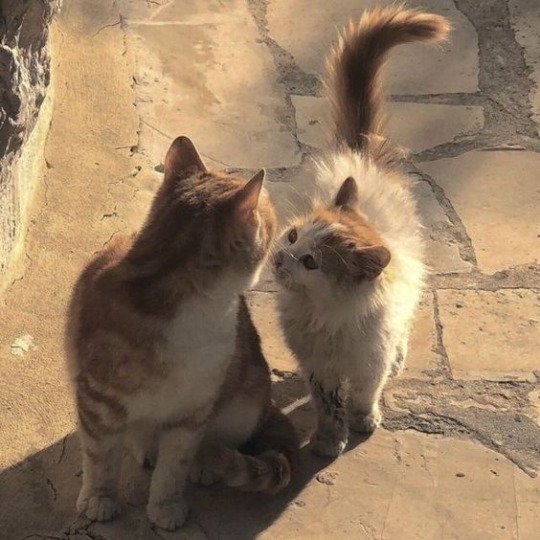
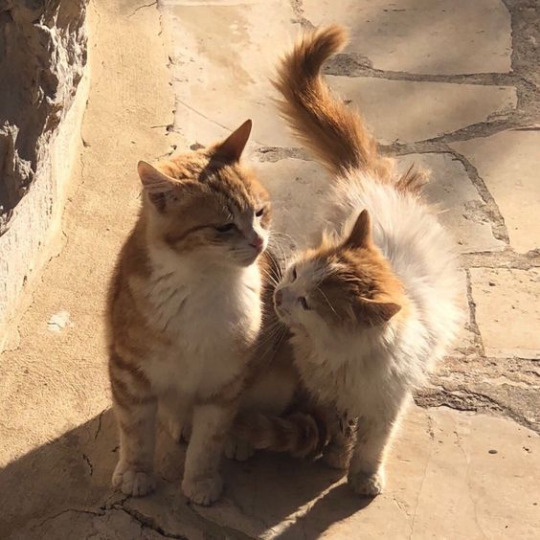
#blame bressy for this#....urgh cats in love...#aaaaaaaaaaaaaaaaaaaaaaaaaaaaaa#excuse me as i go insane#gummmyart#doodle#my oc#my oc art#cod oc#cod oc art#[oc]Raven#Raven[oc]#PriceRaven#captain john price#captain john price x oc#john price x oc#captain price x oc#kitty!Raven#kitty!Price
236 notes
·
View notes
Text

#adam parrish#i'll put Roanan in at some point but yk he canonically hates his phone so i'll blame it on that#character tweets#trc#trc twitter#gangsey tweets#the raven cycle tweets#the raven cycle
130 notes
·
View notes
Text
this most likely would not work within canon so headcanon territory it is, but the way red eyes are associated with grimm, and emerald and the branwen twins being abandoned (orphaned?), with emerald and qrow having this "loved by no one / no one wanted me" thing, and just the general "you're useful so you can stay" attitude that can show up towards emerald's and especially raven's semblances, there's just...
there could be so many superstitions when it comes to red eyes, but it would also require them to be relatively rare and something that can just pop out of nowhere even if neither parent has them, bc otherwise it's like. you're one to talk here lmao.
but like, parents end up having a kid with red eyes -> superstition says there's something "wrong" with the kid—be it possession or whatever—bc red eyes = grimm -> they abandon the kid at some point in life; some soon after, not wanting to take the "risk", some last a little longer but eventually, when something goes wrong, the kid usually gets the blame and off they go.
#rwby#raven branwen#qrow branwen#emerald sustrai#i blame canon paralleling red eyes with silver eyes for this#gets the creative juices flowing
56 notes
·
View notes
Text
Lenore's phases and look through the comic (chronologically):
♤♤♤♤♤♤♤♤♤♤♤♤♤♤♤♤♤♤♤♤♤♤♤♤♤♤♤♤♤♤

Before the storm
♤♤♤♤♤♤♤♤♤♤♤♤♤♤♤♤♤♤♤♤♤♤♤♤♤♤♤♤♤♤

After the storm
♤♤♤♤♤♤♤♤♤♤♤♤♤♤♤♤♤♤♤♤♤♤♤♤♤♤♤♤♤♤

Trapped and insane
♤♤♤♤♤♤♤♤♤♤♤♤♤♤♤♤♤♤♤♤♤♤♤♤♤♤♤♤♤♤

Annabell lee
♤♤♤♤♤♤♤♤♤♤♤♤♤♤♤♤♤♤♤♤♤♤♤♤♤♤♤♤♤♤

Their last meeting
♤♤♤♤♤♤♤♤♤♤♤♤♤♤♤♤♤♤♤♤♤♤♤♤♤♤♤♤♤♤
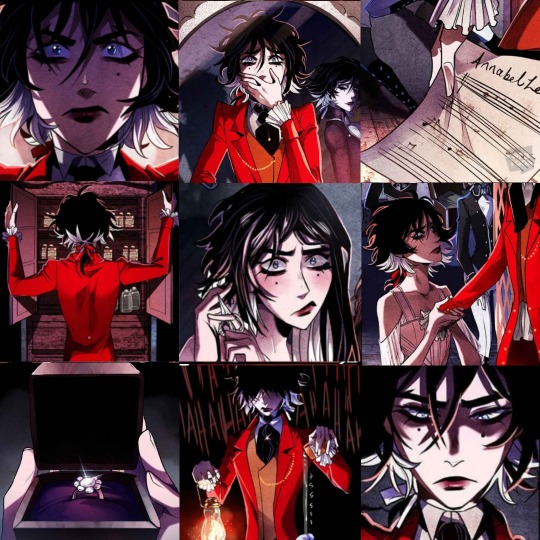
The fire she set for her
♤♤♤♤♤♤♤♤♤♤♤♤♤♤♤♤♤♤♤♤♤♤♤♤♤♤♤♤♤♤

Leo
♤♤♤♤♤♤♤♤♤♤♤♤♤♤♤♤♤♤♤♤♤♤♤♤♤♤♤♤♤♤

Nevermore academy
♤♤♤♤♤♤♤♤♤♤♤♤♤♤♤♤♤♤♤♤♤♤♤♤♤♤♤♤♤♤

Dreamland
♤♤♤♤♤♤♤♤♤♤♤♤♤♤♤♤♤♤♤♤♤♤♤♤♤♤♤♤♤♤

Bonus
(Because I say so)
♤♤♤♤♤♤♤♤♤♤♤♤♤♤♤♤♤♤♤♤♤♤♤♤♤♤♤♤♤♤
#nevermore webtoon#nevermore webcomic#lenore vandernacht#lenore nevermore#white raven#annabel lee whitlock#annabel lee nevermore#insane Lenore is me in the future#I CAN'T DECIDE WHICH ONE IS BEST#This woman is something else#can't blame Annabel for falling for her😔🤲#duke nevermore#aesthetic
357 notes
·
View notes
Text
THREES THREES THREES:
Oh hello. I want to talk about the stylistic/textual role of Threes in The Raven Cycle.
Threes – as a general concept and as a number – are a major symbol and motif in the series. Maggie tells us that threes are important from the very first book: from Maura’s favorite saying being “good things come in threes” to Persephone telling Adam that “things are always growing to three or shrinking to three,” threes are discussed at length in the text of the narrative. Maggie also shows us that threes are important as a motif/symbol for important aspects of the story: three Raven Boys, three Fox Way women, three Lynch brothers, three main ley lines, three sleepers, etc. Threes are, textually, incredibly significant in The Raven Cycle, and we know this because we are shown AND told it throughout the entirety of the books.
We all know the significance that is given to threes in the story itself, but what I want to talk about is the usage of a thrice-repeated word or short phrase (going forward I’m referring to this as “Threes” or “a Three”) as one of Maggie’s writing signatures (across the series, there are 65 Threes). This creates a meta level to threes being an important aspect of The Raven Cycle universe. A classic example of a Three (one of my favorites, in fact) is from The Dream Thieves:
“As they walked, a sudden rush of wind hurled low across the grass, bringing with it the scent of moving water and rocks hidden in the shadows, and Blue thrilled again and again with the knowledge that magic was real, magic was real, magic was real.” (TDT, 12)
In a way, the Threes join the intradiegetic (what is happening within the narrative itself) with the extradiegetic (what the narration is communicating solely to the reader). The reader and characters are told explicitly that the number three is significant, important, notable, and powerful. In using Threes as a writing signature after giving the reader that information, the Threes are designed to signal to the reader that this line, this moment, is important.
So the question is: What Are The Threes Trying to Tell the Reader???
Amazing question.
In my recent TRC reread, I was already keeping track of Threes, because I was curious to see how many times they appeared. And then my sister, who was also rereading, said something interesting (after reading this Three from The Raven Boys):
“He was full of so many wants, too many to prioritize, and so they all felt desperate. To not have to work so many hours, to get into a good college, to look right in a tie, to not still be hungry after eating the thin sandwich he’d brought to work, to drive the shiny Audi that Gansey had stopped to look at with him once after school, to go home, to have hit his father himself, to own an apartment with granite countertops and a television bigger than Gansey’s desk, to belong somewhere, to go home, to go home, to go home.” (TRB, 370)
My sister said: “Adam’s like Dorothy.” And then she said: “Wait. Do you think the Threes are like a spell? Or… a wish?”
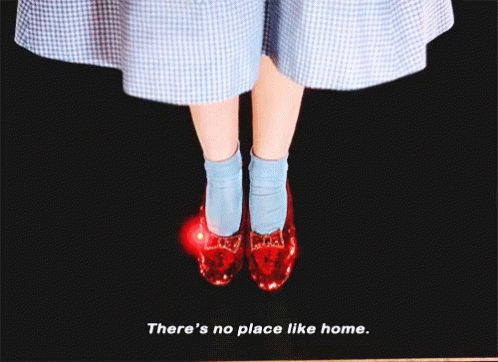
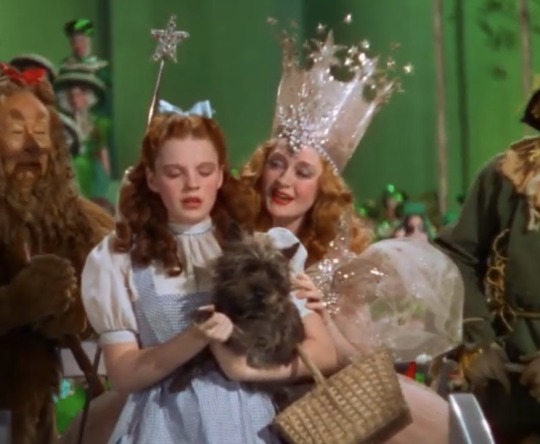
Which was……. Interesting.
What I have determined, after completing my reread and spending way too much time analyzing this, is that a Three is either a wish, a hope, a longing, a prayer – or, alternately, a warning, a curse, a negative promise.
In either sense, Threes are a foreshadowing of what is to come – whether it be good or bad. Threes exist to signal to the reader that they should be paying close attention to whatever is being said or observed.
Threes in….. Everything Else:
Before we get too far into TRC Threes, let’s talk about the precedent for three being an important number in art, math, storytelling, etc. I found some interesting information about how three is a satisfying number for the brain:
Grouping things in threes leverages the power of repetition to aid memory; denote emotional intensity or importance; and ease persuasion (research by Shu & Carlson (2014) found that three positive claims is the most effective for persuasion).
Three is the smallest number that the brain can still recognize as a pattern, and the brain loves pattern and repetition. This is true in visual art – having three main compositional figures to create a pleasing image – and also in storytelling and narrative. Using threes for repetition in storytelling is a very common occurrence.
Some classic examples of repetitive threes are Shakespeare’s “tomorrow and tomorrow and tomorrow” or Lincoln's “a government of the people, by the people, for the people.” In each of these examples, a repetition of three is used to create pleasing auditory rhythm. There is something inherently memorable about literary Threes.
Perhaps the most interesting information I found while digging into the precedent for threes is about the rule of threes in folktales. This information happens to come from Wikipedia (side note: Wikipedia is a modern tool of collective consciousness and we should utilize it more). This page describes how in its most basic form, the rule of threes in storytelling is just beginning, middle, and end. Because this is such a common convention, writers tend to “create triplets or structures in three parts.” It then talks more directly about the use of threes in folktales:
“Vladimir Propp in his Morphology of the Folk Tale, concluded that any of the elements in a folktale could be negated twice so that it would repeat thrice.”
This is especially interesting to me. The idea that an element of a folktale “could be negated twice so that it would repeat thrice” shows up prominently in the plot of The Raven Cycle – a book that is heavily influenced by folktale motifs – but also in so many of the folktales/fairytales we all know. A classic example of this would be Goldilocks and the Three Bears – Goldilocks must try porridge that is too hot, too cold, and then, finally, just right. The journey of these three actions is satisfying to the brain because it is a complete pattern: the third and final result of “just right” porridge is only satisfying because of the two “not right” porridges that preceded it.
Getting back to Stiefvater Threes:
For anyone who’s seen The West Wing (and even those who haven’t), here’s a good way to explain what I think the Threes are doing. You know that thing they do during a The West Wing “walk and talk” where two characters will be throwing information and little quips back and forth at each other rapid-fire, and then suddenly, they will both stop walking, and the camera will stop moving, and they’ll say a line that contains really important information that you need to know to understand the storyline of that episode? That’s what Maggie’s Threes are doing for the reader. That’s what 6:21 is doing for the characters. It’s intentional: the writers/directors/actors/camera operators on The West Wing know that they’re throwing a lot of information at you, and know that they need to get you to pay attention to the most important parts somehow, so they do it by forcing the viewer to lean in and listen. It changes the focus and energy of the scene from something with momentum to something that pauses, and therefore makes you pause.
The Threes compel the reader to pause and consider the information being delivered as more important than they might consider it if it was not written as a Three. “Maura’s expression was dark” does not read the same as “Maura’s expression was dark, dark, dark.” And in a text where characters directly state the magical importance of threes, compounded by three as an overarching motif, there is clear intention and meaning behind these written Threes.
In the context of TRC, Threes act as a fourth-wall break.
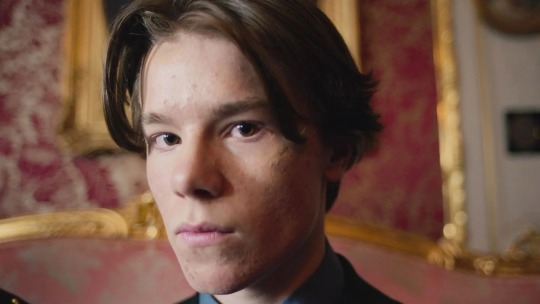
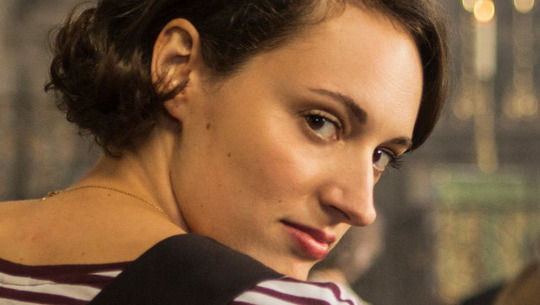
They are essentially a way to poke the reader and say: “Are you paying attention? Because you should be.”
These Threes use a symbolic motif – the rule of three – that is already heavily discussed in the text – to get the reader to pick up on the internal motivations of the character who is “wishing” their Three or the narration which is using a Three to foreshadow some important aspect of the plot.
The Threes are like the literary equivalent of a record scratch. It stops you in your tracks, breaking the established rhythm and making you take notice of what is being said in a new way.
Let’s Look at Some More Threes (but just a few don’t worry)!
1. We get a classic Three, and a very Gansey Three, right after the group comes out of Cabeswater:
“‘What about that thing in the tree?’ Blue asked. ‘Was that a hallucination? A dream?’
Glendower. It was Glendower. Glendower. Glendower” (TRB, 231).
Finding Glendower is one of Gansey’s core wishes, one of his core longings. Although this line is a literal answer to Blue’s question – he saw Glendower in the tree – in making it a Three, Maggie has given it added weight and meaning. It is prayer-like in its intention. It is almost an incantation: by saying it in Three, Gansey wishes it into being.
2. In The Raven Boys, after Gansey has bribed Pinter to keep Ronan at Aglionby and has learned that Noah has been dead the whole time they’ve known him, we are given this Three:
“The Pig exploded off the line. Damn Ronan. Gansey punched his way through the gears, fast, fast, fast” (TRB, 311).
This moment foreshadows what directly follows: a distinct lack of fast as the Camaro breaks down and Gansey is held at gunpoint by Whelk. This Three is not a prayer, but a warning, and an indicator to the reader that something important is about to happen. Had Gansey not been trying to go so “fast fast fast,” the car might not have broken down; because the Three incanted it, disaster follows.
3. To return to a Three I have already mentioned, but follows the typical Three structure:
“...to go home, to go home, to go home” (TRB, 370).
In this scene, Adam’s wish is less about actually wanting to return to his literal home, because his house was never really a home for him. Adam’s wish/longing is for a home that he could return to, that he would want to return to. He is longing for a place/feeling/experience that does not exist for him. The Three in this sentence comes after a string of active wishes/longings, and by ending with this Three, it casts a spell of sorts, honing in on the truest underlying wish that Adam has. In using the phrase “to go home” three times, the narrative is making sure you, the reader, know that this want, this need, this wish, is the most Important to Adam, and will drive his actions for the rest of his story.
Most of the Threes feel like this. They are often tacked on at the end of a sentence or embedded in a sentence. They’re an addendum to the action of the story. They’re like casting a spell – once to manifest, twice to charge, three to cast.
…..And Some Other Types of Threes:
Then there are the Threes that don't follow the typical pattern of the same word repeated three times one right after the other, but are still a Three in a different way.
There are short phrases/sentences that are repeated three times throughout a page or chapter. In the prologue of The Raven King, we get this:
“He was a king…
He was a king…
He was a king.
This was the year he was going to die.” (TRK, 1-3)
In this case, the Three acts as a promise of Gansey’s kinghood, but in ending the sequence with “this was the year he was going to die,” the promise of the three is given a condition: it is not going to be a joyful kinghood, but instead a kinghood intertwined with the death we’ve known is fated for Gansey.
One of Adam’s Threes from Blue Lily, Lily Blue, uniquely breaks the mold of Threes in a format that does not appear anywhere else in the four books:
“It was his father.
He opened the door.
It was his father.
He opened the door.
It was his father” (BLLB, 242).
❋ (We’ll talk about this one more in-depth later.)
There are also a few “unfinished” Threes:
In The Raven King when Ronan is having a nightmare (infected by the demon) about Matthew and the mask, he has this Three:
“Ronan’s throat was raw. I’ll do anything! I’ll do anything! I’ll do anythi
It was unmaking everything Ronan loved.
Please” (TRK, 96).
With the uncompleted Three, there is an uncast wish. Ronan’s wish is about Matthew, yes of course, but also about being willing to do anything to keep those he loves (ie. Adam, Gansey, Blue, his brothers) out of the reach of the “unmaking.” This unfinished Three serves to foreshadow the harm that does ultimately befall first Adam and then Gansey as a result of the unmaking of Cabeswater by the demon: without the Three spell completed, his wish is not fulfilled.
*This is Not all the uncommon/mold-breaking Threes, just a few that are interesting!
Do All Threes Come to Fruition???
The short answer is: No. Or at least not in that way.
Once again looking at the text of The Raven Cycle, we are given an answer of sorts. In discussing Gansey’s predicted death, Maura says:
“First of all, the corpse road is a promise, not a guarantee” (TRB, 155).
This seems to apply to Threes as well. Threes are not a guarantee. They are a promise. Not all Threes come to fruition the way one might expect – or at all, for that matter. The important part of Threes is not that they will definitely come true, it’s that they could come true, because the Three gives them the potential to come true.
Structure, Structure, Structure:
The main Threes structures are:
Three of the same word separated by commas:
“magic, magic, magic” (TRK, 59).
A short phrase/sentence separated by periods:
“My father. My father. My father” (TDT, 369).
A short sentence that is repeated three times throughout a page/paragraph:
“Gansey did not breathe…
Gansey did not breathe…
Gansey did not breathe” (TRK, 209).
A word that is repeated three times and is connected by “and”:
“Round and round and round!” (BLLB, 224)
Italics vs. Non Italics:
Italics in The Raven Cycle are often used for character’s inner thoughts/anxieties. This continues to be true in the context of Threes. A Three that is not written in italics indicates a promise, or some foreshadowing of a plot point being foretold through the Three – it is typically more “real” – whereas a Three that is written in Italics seems to indicate a wish/hope/longing that is unattainable in some way. Italics almost always indicate a Three that may never come to fruition, or at least not in the way the character hopes it will.
An example of this distinction can be found in chapter three (hah) (I don’t believe in coincidences and neither does Gansey) of The Raven King:
First we are met with Ronan wishing/hoping to return home:
“That morning, Ronan Lynch had woken early, without any alarm, thinking home, home, home” (TRK, 24).
This home, home, home, is in reference to the idea of home rather than the reality. Ronan is wishing to return to a home that does exist physically, but is not the same as in his memory – he wants to be at the Barns as it was in his childhood.
Then, in the very same chapter, Ronan actually returns home and we are given this Three:
“Slowly his memories of before — everything this place had been to him when it had held the entire Lynch family — were being overlapped with memories and hopes of after — every minute that the Barns had been his, all of the time he’d spent here alone or with Adam, dreaming and scheming.
Home, home, home” (TRK, 27).
This second home, home, home, is about the actual reality of being in his childhood home – the good and bad that has existed in the years since the childhood he longs for.
The Addition of AND:
The most notable use of “and” is in Noah’s very last chapter:
“Sometimes he got caught in this moment instead. Gansey’s death. Watching Gansey die, again and again and again” (TRK, 416).
When “and” is added into a Three, it becomes circular, cyclical. The “and” gives the Three a sense of infinity, or creates a loop of sorts.
This Three operates in the same way “tomorrow and tomorrow and tomorrow” does in Macbeth – it is meant to convey the endlessness of time, a relentless cycle of tomorrows.
❋ While there are not many of these Threes with “ands” in The Raven Cycle, there are other examples of Threes or Three-like occurrences that fulfill the same purpose as the “and.” For example, remember this Three:
“It was his father.
He opened the door.
It was his father.
He opened the door.
It was his father.” (BLLB, 242).
In this case, instead of the word “and,” the Three (It was his father) is connected by “he opened the door.” This Three is accomplishing the same feeling as “again and again and again” – the feeling of being caught in an endless loop.
Another example of an (implied) “and” in The Raven Cycle is: Gansey’s life. Gansey starts out alive and then dies as a child only to be reborn, and then killed again through his sacrifice, and then reborn for a final time. Gansey is Alive, Dead, Alive, Dead, Alive. And so Gansey’s life is a cycle of Three.
As with the Threes that contain “and,” Gansey starts where he ends: alive.
Other Ways Threes Show up in The Raven Cycle:
I will state the obvious once again: there are three Raven Boys, three Lynch brothers, three Fox Way women, three sleepers, three main ley lines (the lines that “seem to matter” to Glendower’s story), Gansey the Third (Gansey Three, Dick Three).
There are also the more obscure: the “three kinds of secrets” in The Dream Thieves prologue and epilogue; each Lynch brother inheriting three million dollars from Niall Lynch; the three figures with Blue’s face on the tapestry and later as a vision in Cabeswater; Adam and Gansey going to DC for three days; the shield pulled from the lake having three ravens embossed onto it; Ronan having dreamt Matthew at the age of three; the door to the Demon’s room needing “three to open” it; Aurora Lynch staying awake for three days after Niall died.
And of course, we have the ley line symbol/chapter header:
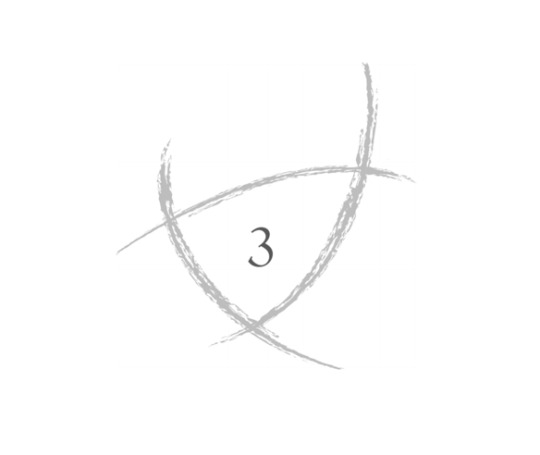
And then there are the 300 (three hundred!) Fox Way “villain” readings. (This was something that was particularly interesting to me.)
The first antagonist we meet is Whelk. When he comes for a reading at 300 Fox Way, he first pulls the Three of Swords.
When the women all draw cards together, they pull identical cards for Whelk: three of the Knight of Pentacles, then three of the Page of Cups. After drawing, essentially, three threes (the Three of Swords, then two sets of three matching cards) in this reading, the first Three of the entire series appears:
“Maura’s expression was dark, dark, dark” (TRB, 124).
The second “antagonist” we meet is the Gray Man, who comes to 300 Fox Way in The Dream Thieves to “observe.” Maura, Calla, and Persephone are predicting which card is on the top and bottom of the stack and the first card, predicted by Calla, is the Three of Cups off the top of the deck that Mr. Gray is holding (a remarkably happy card in stark contrast to Whelk’s Three of Swords).
When the third antagonist, Greenmantle, comes for his 300 Fox Way Reading he also draws the Three of Swords. The fact that each of the three antagonists come for a reading is in itself a sort of Three, but to further the importance of these moments, each of them draws some sort of three-related card.
All of the examples I have touched on have been more symbolic references to Three as a motif of the books as a whole. However, Threes also show up in the literal number of times important quotes are said/written.
I was tracking some of the most well-loved TRC lines to compile them, and noticed that the lines “don’t throw it away” and “safe as life” happen to appear exactly three times throughout the series. This was honestly pretty surprising based on the importance of those quotes – I would have assumed they showed up far more. Actually, they both appear twice in The Raven Boys and once in The Raven King. Threes, and the importance of Threes, is embedded so strongly into the narrative of The Raven Cycle that even the quotes we all think of as the most beloved of the series follow this rule of Threes.
Now, could you chalk some of these up to coincidence? I guess. But Gansey doesn’t believe in coincidences so I don’t either. So what’s the point of all these Threes?
Conclusion???
In a literal, literary way, Threes are a fourth wall break to make the importance of a moment obvious, but I’m not sure what the larger “point” of Threes is. My best analysis comes from the idea of The Raven Cycle being all about time and Threes playing into the importance of time as a sort of record scratch or loop. The Threes, as a stylistic, written motif, seem to connect the time-based cycle the characters experience to the time-based cycles the reader experiences by reading the books.
But my conclusion feels incomplete and so I would like to rely on the collective for this one – just about the most Raven Cycle thing you can do. So I’m asking you, the collective you, what conclusion would you draw? What do you think?
What I do know for sure is that Threes are magic, magic, magic.
For Your Convenience: Here is the textual significance given to threes within the books (chronologically):
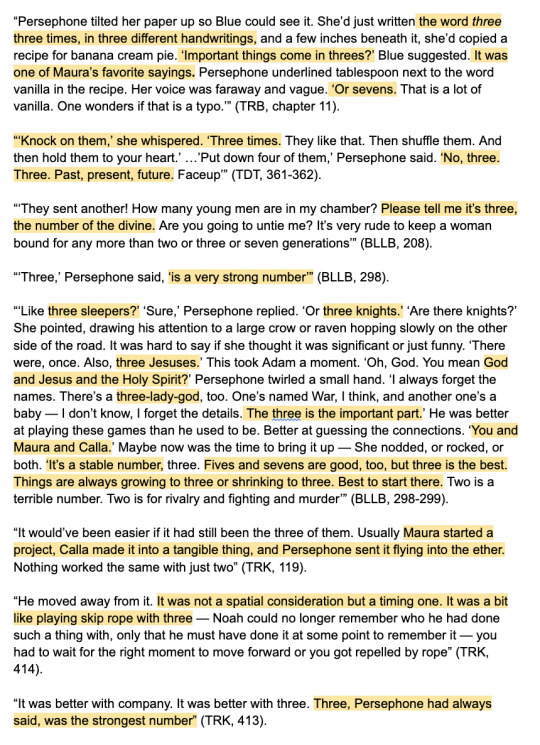
And here are the Threes, Threes, Threes (compiled):


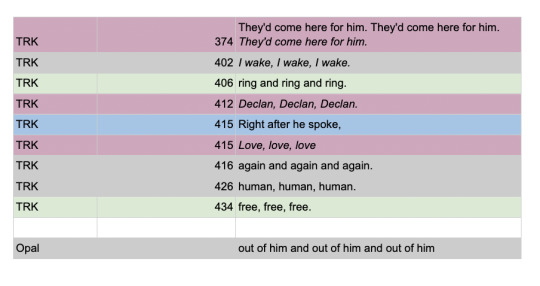
(If you made it to the end of all this, I love you. Have a gold star and a hug <3)
#sorry for the aggressive caps lock i wrote this in google docs#wow this is embarrassing#i'm okay with it#i spent my break writing a 16 page paper#the ganseyism of it all#some people asked for an essay so blame them not me#trc#trc analysis#maggie stiefvater#the raven cycle#the raven boys#the dream thieves#blue lily lily blue#the raven king#the gangsey#blue sargent#richard campbell gansey iii#ronan lynch#adam parrish#noah czerny#gangsey#mine
196 notes
·
View notes
Text



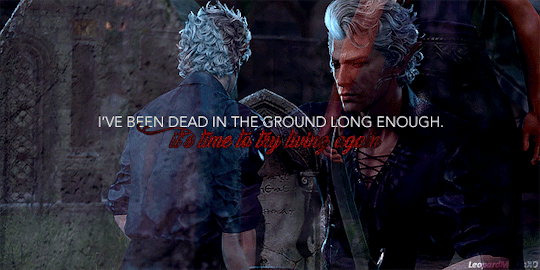

You… I want you. ♡
#bg3#baldur's gate 3#astarion ancunin#my oc: raven ianthe#astarion romance#otp: a perfect blend of aphrodisiacs and arsenic#astarion x tav#my bg3 edits#leopardmuffinxo.edit#userarklay#usermorvaris#userwolfkissed#userlumad#userterendelev#userdekarios#miyku#baldurians#katsigian#useremahriel#userfray#mrdekarios#please let me know if you do or do not want to be tagged#i made the first gif and almost gave up with the others b/c i liked it so much#blame the perfectionist gremlin in my head#working on evicting them lmao
321 notes
·
View notes
Text
it’s kinda sad that all the creative insults jean came up w in tsc, did anyone notice than none of them were aimed at riko…? like literally none of them. not a single one.
#i wonder why#is jean ever gonna hold riko accountable#or will he continue to blame his parents#the master#kevin#the raven coaches#and everyone who wronged him except yk…#THE MAIN GUY#the sunshine court#all for the game#aftg#jean moreau#kevin day
55 notes
·
View notes
Text
i have been saying “come on, provolone” all week and probably won’t stop for 6 months, thanks for asking
#aabria if you’re reading this i blame you for this#dimension 20#the ravening war#the ravening war spoilers#trw#colin provolone
551 notes
·
View notes
Text
real photo of me at college showing Ever After High to people
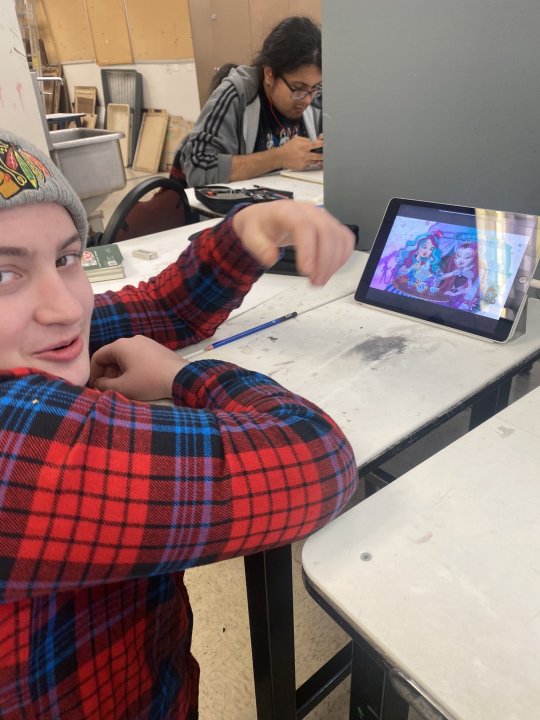
it was an attempt at indoctrination (failed)
#you cannot blame me.#eah#ever after high#raven queen#maddie hatter#madeline hatter#shitpost#dunconcerning
119 notes
·
View notes